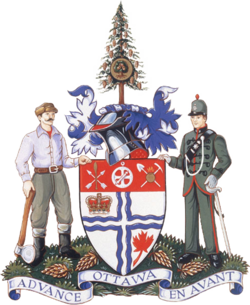Ottawa City Council Conseil municipal d'Ottawa (French) | |
|---|---|
| 2022–2026 term | |
 | |
| Type | |
| Type | Unicameral city council |
| History | |
| Founded | 2001 |
New session started | November 15, 2022 |
| Leadership | |
Mayor (head of council) | Mark Sutcliffe since November 15, 2022 |
Deputy Mayors | |
| Structure | |
| Seats | 24 plus the Mayor |
 | |
Political groups | |
Length of term | Four years, renewable |
| Authority | Municipal Act, 2001 City of Ottawa Act |
| Salary | CA$111,111 [1] |
| Elections | |
First election | September 11, 1847 (7 seats) |
Last election | October 24, 2022 (25 seats) |
Next election | October 26, 2026 (25 seats) |
| Meeting place | |
 | |
| Andrew S. Haydon Hall [2] Ottawa City Hall Ottawa, Ontario | |
| Website | |
| ottawa | |


1. Orléans East-Cumberland Ward
2. Orléans West-Innes Ward
3. Barrhaven West Ward
4. Kanata North Ward
5. West Carleton-March Ward
6. Stittsville Ward
7. Bay Ward
8. College Ward
9. Knoxdale-Merivale Ward
10. Gloucester-Southgate Ward
11. Beacon Hill-Cyrville Ward
12. Rideau-Vanier Ward
13. Rideau-Rockcliffe Ward
14. Somerset Ward
15. Kitchissippi Ward
16. River Ward
17. Capital Ward
18. Alta Vista Ward
19. Orléans South-Navan Ward
20. Osgoode Ward
21. Rideau-Jock Ward
22. Riverside South-Findlay Creek Ward
23. Kanata South Ward.
24. Barrhaven East Ward.
Ottawa City Council (French : Conseil municipal d'Ottawa) is the governing body of the City of Ottawa, Ontario, Canada. It is composed of 24 city councillors and the mayor. The mayor is elected at large, while each councillor represents wards throughout the city. Council members are elected to four-year terms, with the last election being on October 24, 2022. The council meets at Ottawa City Hall in downtown Ottawa. Much of the council's work is done in the standing committees made up of sub-groups of councillors. The decisions made in these committees are presented to the full council and voted upon.
Contents
- Standing Committees
- Advisory Committees
- 2022–2026 members
- 2018–2022 members
- 2014–2018 members
- 2010–2014 members
- 2006–2010 members
- 2003–2006 members
- 2001–2003 members
- 1997–2000 members
- 1994–1997 members
- 1991–1994 members
- 1988–1991 members
- 1985–1988 members
- 1982–1985 members
- 1980–1982 members
- 1978–1980 members
- 1977–1978 members
- 1975–1976 members
- 1973–1974 members
- 1970–1972 members
- 1967–1969 members
- 1965–1966 members
- 1963–1964 members
- 1961–1962 members
- 1959–1960 members
- 1957–1958
- 1955–1956
- 1953–1954
- 1951–1952
- 1949–1950
- 1947–1948
- 1945–1946
- 1943–1944
- 1941–1942
- 1940
- 1939
- 1938
- 1937
- 1936
- 1935
- 1934
- 1933
- 1932
- 1931
- 1930
- 1929
- 1928
- 1927
- 1926
- 1925
- 1924
- 1923
- 1922
- 1921
- 1920
- 1919
- 1918
- 1917
- 1916
- 1915
- 1914
- 1913
- 1912
- 1911
- 1910
- 1909
- 1908
- 1907
- 1906
- 1905
- 1904
- 1903
- 1902
- 1901
- 1900
- 1899
- 1898
- 1897
- 1896
- 1895
- 1894
- 1893
- 1892
- 1891
- 1890
- 1889
- 1888
- 1887
- 1886
- 1885
- 1884
- 1883
- 1882
- 1881
- 1880
- 1879
- 1878
- 1877
- 1876
- 1875
- 1874
- 1873
- 1872
- 1871
- 1870
- 1869
- 1868
- 1867
- 1866
- City Halls
- See also
- References
- External links